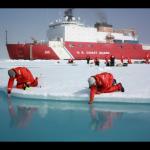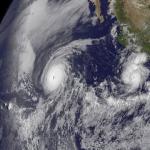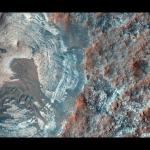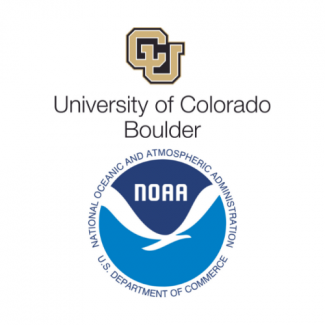CIRES/NOAA Science@Home
Speaker Series | Connecting your virtual classroom directly with scientists
The CIRES/NOAA Science-at-Home webinar series is intended to connect middle and high school students that are now in the virtual/remote learning landscape with scientists. Each webinar features a 10-15 minute presentation by scientists about how they got into science, what they do as a scientist, and what it is that they research, followed by 10-15 minutes of live Q&A.
Webinars can be viewed in any order as each stand-alone.
These webinars ran weekly in the Spring and Fall of 2020 and feature a broad range of scientists working in climate science, polar science, ocean science, and atmospheric science.
Looking for our monthly Spanish-language series?
CIRES/NOAA Serie La Ciencia-en-Casa
Program Team
Videos

Catastrophic Glacier Collapse with Mylène Jacquemart
In this webinar, Mylène Jacquemart talked about her research working to ID triggers of sudden glacier detachments: destructive glacial process that buried kilometers of Alaskan forest.
This webinar is part of the CIRES/NOAA…

Experience and Capture the Arctic on Film with Lianna Nixon
Videographer Lianna Nixon presents about her experiences on the MOSAiC Expedition and filming a planetarium show in the Arctic Circle.

Environmental Economics with Matthew Burgess
Dr. Matthew Burgess talks about science policy and how math, economics, and climate science are related.

About Arctic Sea Ice with Walt Meier
Dr. Walt Meier presents on Sea Ice (What it is and why we study it)

Ice Dynamics with Twila Moon
In this Science@Home Twila Moon presents on Greenland and Ice Dynamics.

Radar & Remote Sensing of Glaciers with Ryan Cassotto
Dr. Ryan Cassotto presents on: Radars and Remote Sensing of Glaciers.

Fossils: Earth's History & Dinosaur Extinction with Julio Sepúlveda
Dr. Julio Sepúlveda presents: What do fossil molecules tell us about Earth’s history and the extinction of dinosaurs?

The Changing Arctic Carbon Cycle with Aleya Kaushik
In this webinar, Dr. Aleya Kaushik, a water-carbon cycle scientist at NOAA GMD, presents on the Arctic Climate Cycle.

Hurricanes with Rosimar Rios-Berrios
In this webinar, Dr. Rosimar Rios-Berrios presented on her research in hurricanes, cyclones, and forecasting.

Seismology with Mel Zhang
Learn about seismology with Mel Zhang, in this 30-minute webinar on seismology - what it is and how Mel got into it.

Wildfires and Insects Kill Trees with Mike Koontz
Dr. Koontz presented on: Understanding Where Wildfires and Insects Kill Trees Using Drones and Satellites.

Wildfires & Crop Burning Smoke with Shuka Schwarz
Joshua (Shuka) Schwarz is a research scientist in NOAA's Chemical Science Laboratory. In this presentation he talks about wildfire and crop burning smoke and what it's like to be a scientist.

Flash Droughts with Andy Hoell
Dr. Hoell presents on: Flash Drought
(Flash Droughts are defined as an event with greater than or equal to two categories degradation in a four-week period based on the U.S. Drought Monitor.)
Andy Hoell works in NOAA's Physical Sciences Laboratory. He researches the predictability of weather and…

The Formation of New Guinea & History of Our Climate with Peter Martin
Dr. Peter Martin presented on his research in and of New Guinea. In particular, when did it form and how it impacted historical climate change.
This webinar is part of the CIRES/NOAA Science-At-Home series.

Burial of Alaskan Forests: Glacier Detachments with Mylène Jacquemart
In this webinar, Mylène Jacquemart talked about her research working to ID triggers of sudden glacier detachments: destructive glacial process that buried kilometers of Alaskan forest.

Ocean-Atmosphere Interactions with Elizabeth Thompson
In this webinar, Dr. Elizabeth Thompson discussed how learning about weather can also teach us a lot about the ocean - it's the same but backwards. The oceans impact weather across the entire world, but these invisible interactions are some of the most difficult to measure or predict. This webinar is part of…

Microbial life in Antarctic soils (and Mars): with Noah Fierer
In this webinar, Dr. Noah Fierer presented on his recent work looking at the microorganisms living in soils of Antarctica, one of the driest and coldest places on Earth. He discussed how and why he went to Antarctica to study these microorganisms and what they can tell us about life on our planet and the…

The Greenland Ice Sheet with Lincoln Pitcher
In this webinar, Dr. Lincoln Pitcher presented on recent research about meltwater production, transport and export from the Greenland Ice Sheet. He talked about what glacier hydrology field research in Greenland is like, and why studying Greenland Ice Sheet hydrologic processes is important.
This…

Stratospheric Polar Vortex & Weather with Amy Butler
In this webinar, Dr. Amy Butler talked about the Polar Vortex. She focused on why she became an atmospheric scientist, presented a brief overview of the stratosphere and the ozone layer, and discussed how we might use information about the stratospheric polar vortex to make extended-range weather…

Precipitation with Janice Bytheway
In this webinar, Dr. Janice Bytheway talked about precipitation - how it forms, and a little bit on how we observe and predict it.
This webinar is part of the CIRES/NOAA Science-At-Home series.

Antarctica with Ted Scambos
In this webinar, check back for the recording, Dr. Ted Scambos presented a 'science travelogue' for the continent of Antarctica. His nineteen expeditions to Antarctica, in every region of the continent and the sea ice that surrounds it, has made him an expert in the field.
He has…






